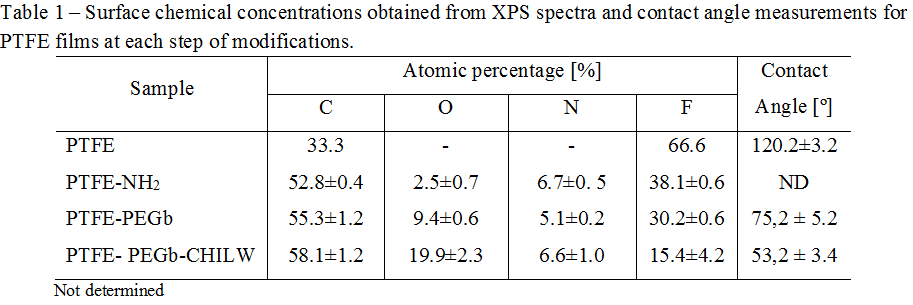Introduction: Bacterial contamination is a public health and socio-economic problem. In Canada, 220,000 people develop nosocomial infections each year for an annual cost of $106.4 million[1]. The surface is the main responsible for the spread of bacterial contamination. To prevent contaminations, the development of antimicrobial surfaces for medical devices is investigated. Chitosan is a promising candidate for the development of new functionalized biomaterials because it is a nontoxic and biocompatible polymer with antimicrobial action[2],[3]. In this work, polytetrafluoroethylene films (PTFE), commonly used in surgery and medical applications, were functionalized using plasma treatment and PEGb (poly(ethylene glycol)bis(carboxymethyl)) was used to link chitosan molecules aiming to add antibacterial features.
Materials and Methods: PTFE films (0.25 mm of thickness; 3.0 x 3.0 cm2) were washed with acetone, deionized water and methanol in ultrasonic bath. After, PTFE samples were aminated by atmospheric DBD (dielectric barrier discharge) plasma, then grafted by PEGb, activated with EDAC (N-(3-dimethylaminopropyl)-N’-ethylcarbodiimide hydrochloride) in MES (2-(N-morpholino)ethanesulfonic acid hydrate) buffer. The activated film was reacted during 3 h with chitosan at 2% w/v, in aqueous solution of acetic acid 1% (v/v). Samples were washed with water before use. Surface modifications were assessed by X-Ray Photoelectron Spectroscopy (XPS) for surface chemical composition, by water contact angle (CA) for wettability and by Scanning Electronic Microscopy (SEM) for surface morphology.
Results and Discussion: XPS results showed that chitosan was successfully grafted to the surface (Table 1).

Indeed, after plasma treatment (N2/H2), 6.7% of nitrogen atoms were detected and PEGb grafting was evidenced by the decrease of fluorine as well as the increase of the oxygen and carbon elements. Chitosan grafting, with its polysaccharide structure, was indicated by highest carbon, nitrogen and oxygen percentage with a decrease in fluorine concentration. PEGb surfaces exhibited low contact angle values with water. In the case of chitosan grafted surfaces, CA was lower than PEGb surfaces, mainly due to the introduction of polar functional groups present in chitosan structure. These modifications were also shown by SEM images (Figure 1) that depicted a homogeneous coating without the formation of clusters on the PTFE surface.

Conclusion: Results showed that plasma treatments combined with grafting of PEGb and chitosan constitute potential techniques for the achievement of functionalized coatings. The surface modification efficiency has been evidenced both by XPS and CA analyses. Furthermore, PEGb-CHI coatings exhibit a homogenous coverage of the PTFE surfaces. These observations suggest that chitosan surfaces, grafted trough PEG, is a high potential candidate to obtain antibacterial devices. Thus, the next step is to investigate the antibacterial effect of this coating on Escherichia coli as well as Staphylococcus aureus.
This work was partially supported by NSERC-Canada, CIHR-Canada, CFI-Canada, FRQ-NT-Quebec, MRI-Quebec and, CNPq Brazil.
References:
[1] Online data on www.ipac-canada.org, consulted on 08 Sept 2015.
[2] M. Dash, F. Chiellini, R. M. Ottenbrite, and E. Chiellini, Chitosan-a versatile semi-synthetic polymer in biomedical applications. Prog. Polym. Sci. 36, 981 (2011).
[3] E. I. Rabea, M. E.-T. Badawy, C. V. Stevens, G. Smagghe, and W. Steurbaut, Chitosan as antimicrobial agent: Applications and mode of action. Biomacromolecules 4, 1457 (2003).